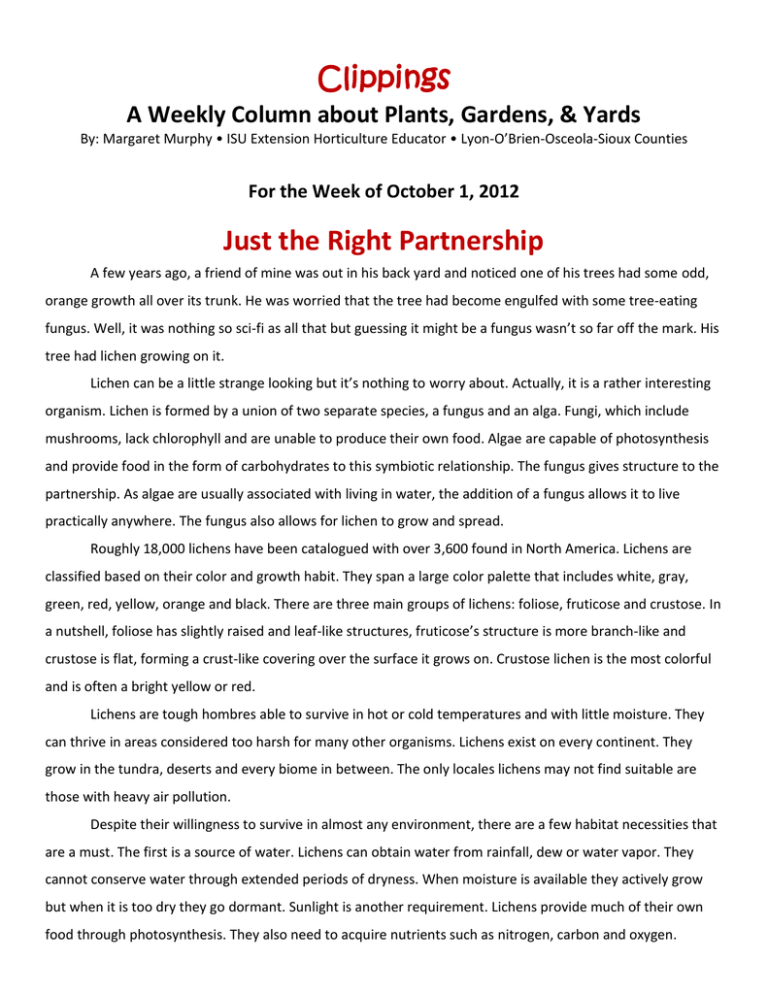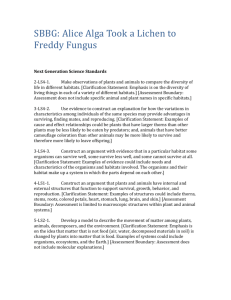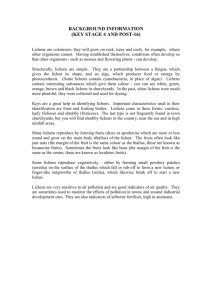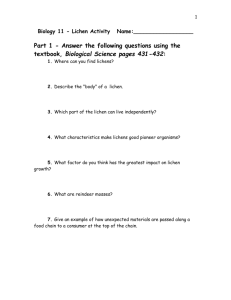October 1 - Lichen - Iowa State University Extension and Outreach
advertisement

Clippings A Weekly Column about Plants, Gardens, & Yards By: Margaret Murphy • ISU Extension Horticulture Educator • Lyon-O’Brien-Osceola-Sioux Counties For the Week of October 1, 2012 Just the Right Partnership A few years ago, a friend of mine was out in his back yard and noticed one of his trees had some odd, orange growth all over its trunk. He was worried that the tree had become engulfed with some tree-eating fungus. Well, it was nothing so sci-fi as all that but guessing it might be a fungus wasn’t so far off the mark. His tree had lichen growing on it. Lichen can be a little strange looking but it’s nothing to worry about. Actually, it is a rather interesting organism. Lichen is formed by a union of two separate species, a fungus and an alga. Fungi, which include mushrooms, lack chlorophyll and are unable to produce their own food. Algae are capable of photosynthesis and provide food in the form of carbohydrates to this symbiotic relationship. The fungus gives structure to the partnership. As algae are usually associated with living in water, the addition of a fungus allows it to live practically anywhere. The fungus also allows for lichen to grow and spread. Roughly 18,000 lichens have been catalogued with over 3,600 found in North America. Lichens are classified based on their color and growth habit. They span a large color palette that includes white, gray, green, red, yellow, orange and black. There are three main groups of lichens: foliose, fruticose and crustose. In a nutshell, foliose has slightly raised and leaf-like structures, fruticose’s structure is more branch-like and crustose is flat, forming a crust-like covering over the surface it grows on. Crustose lichen is the most colorful and is often a bright yellow or red. Lichens are tough hombres able to survive in hot or cold temperatures and with little moisture. They can thrive in areas considered too harsh for many other organisms. Lichens exist on every continent. They grow in the tundra, deserts and every biome in between. The only locales lichens may not find suitable are those with heavy air pollution. Despite their willingness to survive in almost any environment, there are a few habitat necessities that are a must. The first is a source of water. Lichens can obtain water from rainfall, dew or water vapor. They cannot conserve water through extended periods of dryness. When moisture is available they actively grow but when it is too dry they go dormant. Sunlight is another requirement. Lichens provide much of their own food through photosynthesis. They also need to acquire nutrients such as nitrogen, carbon and oxygen. Lichens can “fix” nitrogen from the air and transform it into a usable form for plants much like certain bacteria fix nitrogen in the soil. A deciding factor as to whether lichen can colonize an area is the type of substrate available. Since lichens live on top of something else, they require an undisturbed place to anchor. Trees, rocks, soil, roof shingles and tombstones are all sites where you can commonly find them growing. While living out on Cape Cod, I took long walks over the sand dunes along the beach. I always kept an eye out for the delightful little green lichen with a red cap known as ‘British Soldier’. It would grow on the worn-down snow fences positioned to control erosion. Lichen is often found spread out on the trunks of trees. It does not harm the tree or deprive it of nutrients. It is the exposure to sun due to the absence of foliage that creates an ideal spot for lichen to grow. For the same reason you may notice lichen covering a dead tree limb. Seeing lichen is a favorable sign. It indicates that the local air quality is good. Because they absorb everything from nutrients to toxins, clean air is another essential element for lichens to flourish. Very few lichens are found near dense urban areas with high levels of air pollution. Due to their sensitivity to pollutants, scientist often study lichens as part of their environmental monitoring of an area. Lichens are an important and beneficial part of our world. They provide food and shelter to many organisms. In Alaska, they are a primary food source for reindeer as well as supplemental food for a variety of other critters. A large number of birds and insects use lichens for nesting material. Humans also have numerous uses for lichens. We put them in dyes, paints, toothpastes, deodorants and perfumes. With their antibacterial properties, they are often used in salves and other medicines. Currently, they are being looked at for their promising potential in the treatment of certain cancers and viral infections. So next time you are out and about, see how many different types of lichens you can find. And I hope you will marvel, as I do, at how diverse, adaptable and delightful they are. For further information take a look at the ISU Extension and Outreach publication titled Lichens. For any questions, please feel free to contact me at my email mmurphy@iastate.edu, by phone at (712) 754-3648 or through your local County Extension office. Additional information was provided by the US Forest Service. ###






